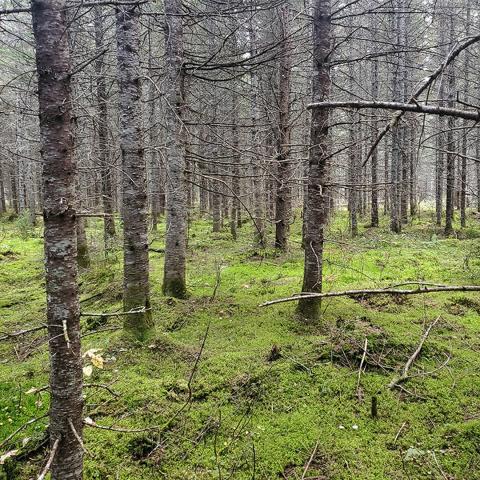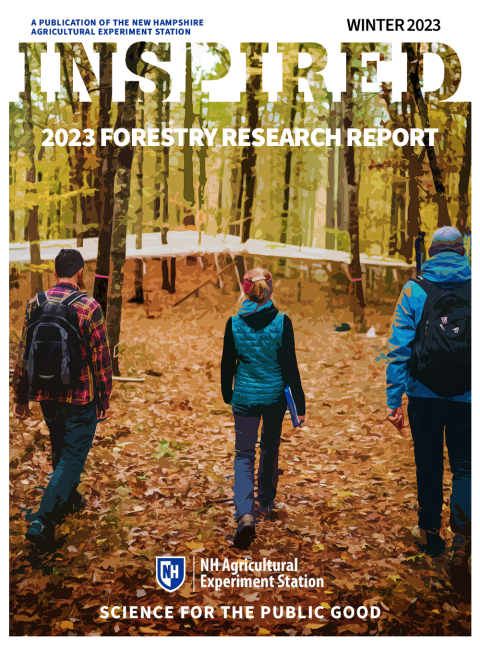Key Findings

Balsam fir was classified as a tertiary species due to its modest timber value potential and susceptibility to fungal damage and spruce budworm.
In northern New England, balsam fir has been increasing in stocking, raising forest health concerns due to another impending spruce budworm outbreak.
Silviculture practices should consider preferential harvest of marketable balsam fir—either to make room for existing trees of more valuable species or to create large enough gaps for regeneration of a diverse mix of species.
About the Co-Author

Mark Ducey, Professor of Natural Resources and the Environment
Contact information: Mark.Ducey@unh.edu, Scholars profile
This research was published in the INSPIRED: A Publication of the New Hampshire Agricultural Experiment Station (Winter 2023)
In many parts of the country, the desirability and usability of trees helps to shape land management practices. In the northeastern U.S., decades of forest harvesting patterns have left some forestland with a deficit of desirable trees species. A series of analyses using U.S. Forest Service Forest Inventory and Analysis National Program data highlighted opportunities aimed at improving regional timber productivity and value by focusing on better species composition and individual tree quality. As part of these analyses, balsam fir (abies balsamea) was classified as a tertiary species, instead of a more desirable primary or secondary species. This research sought to identify reasons for this classification of the balsam fir and provide recommendations for land managers based on these reasons.
This study grouped all tree species in New England and New York into four categories:
- Primary species preferred for commercial use, commanding the highest sawlog prices.
- Secondary species with consistent markets but lower sawlog prices.
- Tertiary species with sawlog markets but are compromised by forest health concerns, frequent defect or having only specialized markets.
- Non-commercial and non-native invasive species.
Generally, balsam fir is at best used for structural lumber, but most of the harvested resource goes to lower-priced pulp or biomass. Based on those factors alone, the species was not classified as a primary timber species.
Balsam fir is also notoriously shallow-rooted, meaning it is prone to windthrow—uprooting or overthrowing of a tree caused by wind—and fungal attack, especially if the roots have been damaged during earlier harvesting operations. It is also the preferred food of the spruce budworm (Choristoneura fumiferana), which has outbreaks on a roughly 40-year cycle. The next regional outbreak is already underway in Canada. Combined with its relatively low commercial value, these factors further move balsam fir from the secondary to the tertiary classification.
This study also examined trends in stocking across the region and over time, using a relative density measure developed in UNH's Ecological Forestry lab over a decade ago. The relative density measure accounts for how resources for growth are partitioned among species in a stand.
Balsam fir was one of the few species increasing in stocking over time in northern New England, supposedly as a rebound following the last major spruce budworm outbreak several decades ago. Increased balsam fir stocking levels should serve as a warning of potential forest health.
For most landowners, it makes sense to harvest marketable balsam fir preferentially. This would enable them either to free resources for the growth of existing trees of primary or secondary classification, or to create sufficiently large gaps for the natural regeneration of a diverse species mix.
A diverse species portfolio could include balsam fir, which possesses many positive non-timber attributes. For instance, it is a preferred species for Christmas trees in the region and for landscaping. However, because of its tertiary classification, it can be a riskier tree within a mixed species portfolio.
Property owners and land managers should pay attention to those stands where balsam fir is a major component of stocking and carefully plan the future of those stands.

Forest stands dominated by balsam fir have lower potential for high-quality forest products and a higher probability of forest health concerns compared with stands dominated by quality trees of primary or secondary species. Photo: M. Thompson.
Related published research
- Forest Ecology and Management: A stand density index for complex mixed species forests in the northeastern United States
- Forest Ecology and Management: Evaluating degradation in a North American temperate forest
- Journal of Forestry: Patterns in Forest Harvesting in New England and New York: Using FIA Data to Evaluate Silvicultural Outcomes
This material is based on work supported by the NH Agricultural Experiment Station through joint funding from the USDA National Institute of Food and Agriculture (under Hatch award number 1020142) and the state of New Hampshire. Authored by J. Gunn and M. Ducey.
This material is based on work supported by the NH Agricultural Experiment Station through joint funding from the USDA National Institute of Food and Agriculture (under Hatch award number 1020142) and the state of New Hampshire. Authored by J. Gunn and M. Ducey.



